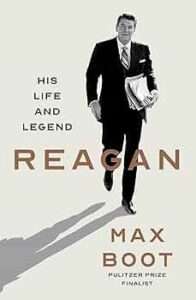Looking at Reagan Through the Lens of Trump
Max Boot's biography of Ronald Reagan is deeply researched and informative, but it sometimes stumbles when it tries to use the past to make sense of the present.

Reagan: His Life and Legend, by Max Boot, Liveright, 836 pages, $45
Max Boot believes "the biographer's job is to find the compromises and expose the shibboleths and then to report on them dispassionately, not to cover them up or exaggerate their importance, so that readers can make up their own minds." In Reagan: His Life and Legend, the first comprehensive biography of President Ronald Reagan since Donald Trump entered the White House, the historian and Washington Post columnist mostly succeeds at that. But understanding Reagan through the lens of Trump does at times lead the author astray.
Boot maintains a neutral and dispassionate tone for most of the book, and he captures Reagan's willingness to work with those he disagreed with ideologically. "Reagan's pragmatism," Boot writes, "resulted in budget deals, trade deals, welfare reform, tax legislation, immigration reform, and, most significant of all, the first US-Soviet treaty to abolish, not just limit, an entire class of nuclear weapons." For Boot, Reagan was a prudent conservative whose willingness to compromise made him a successful statesman.
What Boot calls prudence, hardline conservatives at the time saw as abandoning his principles. The most important example of this was the president's dealings with the USSR. Reagan was both an anticommunist and a nuclear abolitionist, and those two impulses clashed throughout his time in office. Initially, his anticommunist rhetoric often got in the way of meaningful reproachment with the East Bloc: He had always been willing to work with Soviet leaders, but his public pronouncements made it difficult for them to trust him. But after bringing on George Schultz as secretary of state, and after a series of events in 1983 brought the two sides to the brink of nuclear disaster, Reagan deliberately emphasized his willingness to reduce nuclear weapons.
Happily, he had a willing partner in Moscow: Soviet leader Mikhail Gorbachev also wanted to establish better relations. Were it not for Gorbachev, Boot argues, the Soviet Union would likely still exist today. Gorbachev wanted to deescalate tensions and reform the communist system, and his domestic policies reduced corruption and allowed more market activity and political freedom. With his eventual announcement that the USSR would not use force to keep Eastern Europe within the fold, he ensured the Cold War's end.

Boot rejects the notions that Reagan had a grand strategy to win the Cold War, that Reagan's military buildup forced the Soviets to negotiate, and that the president's prophetic words urging Gorbachev to tear down the Berlin Wall led to the wall's collapse. Instead, he suggests that Reagan's most important role in propelling the superpowers toward peace was to work with his Soviet counterpart to decrease tensions and give Gorbachev leeway to implement his reforms. As Boot puts it, "Reagan did not initiate the changes sweeping the Soviet Union, but he was shrewd enough to support them." He adds that "few other leaders have shown as much boldness or flexibility in changing with the times" and that Reagan "was willing to abandon the dogmas of a lifetime when it became evident they no longer applied to a changing world."
Boot also notes Reagan's unwillingness to do much to promote socially conservative legislation. When it came to abortion, school prayer, and even the AIDS epidemic, Reagan refused to prioritize cultural conservatives' perspectives. The president was pragmatic enough to recognize that he could not get anti-abortion or pro–school prayer legislation through Congress. Likewise, Boot demonstrates that Reagan rejected the coercive controls some conservatives proposed for dealing with AIDS, such as mandatory tests and quarantines, and that he infuriated them by supporting Surgeon General C. Everett Koop's willingness to promote information about safe sex. Boot thinks Reagan could and should have done more to combat the epidemic, but he also acknowledges that the response would have been much worse if the president had listened to the most bigoted voices around him.
One area where Boot goes too far in diminishing Reagan's importance is economic policy. His book gives Federal Reserve Chair Paul Volcker the bulk of the credit for the economic recovery of the 1980s. Volcker undoubtedly deserves praise for getting inflation under control, but Reagan's tax cuts, the most dramatic since the 1920s, contributed to the economic recovery, as did his continuation of the Carter administration's deregulation and his insistence on decreasing the number of new regulations created each year. These policies helped set the stage for the technological advancements that would transform the American economy in the years ahead.
Boot dismisses Reagan's seven straight years of impressive economic growth by comparing them to the growth rates of previous decades and the 1990s. These were standard numbers, he argues. But as economies develop, their growth rates tend to decline. In that context, it really was impressive to post seven straight years of economic growth, and for the average across a presidency to be around 3.6 percent. And the strong growth rates of the 1990s were a product of the fiscally conservative principles that Reagan championed, even if he didn't always follow them himself.
Boot also buys into the doom narrative, common these days on both the progressive left and the nationalist right, in which Reagan's policies produced "long-term income stagnation for the working class, a hollowing out of the middle class, and a widening of income inequality." But when Reagan helped usher in an era of lower taxes, lower inflation, less regulation, and freer trade, the result was an explosion of wealth creation that has dramatically raised American incomes.
Real hourly compensation for all workers has increased by around 50 percent over the past 40 years. Middle-class incomes are up more than 60 percent in real terms since 1970. The percentage of Americans defined as poor or near poor has fallen since 1967 from 16 percent to 13 percent. The number of Americans in the lower middle class has also shrunk, from 31 percent to 16 percent today. Where have they gone if they didn't become poor? They got richer: The percentage of Americans in the upper middle class grew from 6 percent to 33 percent. Meanwhile, income inequality has grown only slightly, once taxes and transfers are considered, and it is well within the 20th century average. And the share of national income going to employees is at about the same level now as it was in the 1970s.
Boot's book also falls short of an impartial analysis of Reagan's presidential campaigns. Instead, he parrots the old narrative that Reagan "dog-whistled Dixie" in 1980 to win over former supporters of George Wallace, the Alabama segregationist who had run in the previous four presidential contests. It is true that Reagan spoke at the Neshoba County Fair, near the spot where three civil rights workers had been murdered and declared that he believed in "states' rights." But if you use the moral and cultural lens of 2024 to evaluate Reagan, you need to apply the same standard to other actors on the stage—and if you do that, Reagan's actions seem less like a telling outlier and more like a sign of the times.
Reagan's Democratic opponent, President Jimmy Carter, used southern segregationists on the campaign trail to appeal to Wallace voters. Wallace himself endorsed Carter in both 1976 and 1980, and he cut radio campaign commercials for Carter. By 1980, Wallace had repudiated segregation, but he still held sway with a large segment of the southern electorate some of which had not changed their views on segregation. Two of Carter's top surrogates in the South were Sen. Jim Eastland (D–Miss.) and Rep. John Sparkman (D–Ala.)—both signatories of the Southern Manifesto, a 1956 declaration against racial integration in public spaces. The sad reality is that both Democrats and Republicans were willing to use dog whistles and surrogates with ugly pasts to reach Wallace voters.
Historians, and journalists writing history, have an obligation to contextualize the events that they are writing about, but they also need to speak to their audience who live in the present. This sometimes goes awry when Boot tries to use Reagan's story to foreshadow the rise and appeal of Trump, stretching to draw connections between two very different men who governed at two very different times. In his analysis of Reagan's trade policies, Reagan's penchant for exaggeration, Reagan's views on race, and even Reagan's handling of the AIDS epidemic, Boot draws often dubious connections between the 40th and 45th presidents. History can help us understand the present, but I fear that Boot's insistence on explaining Trump may also date his biography.
Still, this is a well-written, deeply researched, and relatively fair book. There is still no definitive biography of Reagan, but this is a good place to begin.




Show Comments (17)